Microbiota modulation counteracts Alzheimer's disease progression influencing neuronal proteolysis and gut hormones plasma levels
- PMID: 28546539
- PMCID: PMC5445077
- DOI: 10.1038/s41598-017-02587-2
Microbiota modulation counteracts Alzheimer's disease progression influencing neuronal proteolysis and gut hormones plasma levels
Abstract
Gut microbiota has a proven role in regulating multiple neuro-chemical pathways through the highly interconnected gut-brain axis. Oral bacteriotherapy thus has potential in the treatment of central nervous system-related pathologies, such as Alzheimer's disease (AD). Current AD treatments aim to prevent onset, delay progression and ameliorate symptoms. In this work, 3xTg-AD mice in the early stage of AD were treated with SLAB51 probiotic formulation, thereby affecting the composition of gut microbiota and its metabolites. This influenced plasma concentration of inflammatory cytokines and key metabolic hormones considered therapeutic targets in neurodegeneration. Treated mice showed partial restoration of two impaired neuronal proteolytic pathways (the ubiquitin proteasome system and autophagy). Their cognitive decline was decreased compared with controls, due to a reduction in brain damage and reduced accumulation of amyloid beta aggregates. Collectively, our results clearly prove that modulation of the microbiota induces positive effects on neuronal pathways that are able to slow down the progression of Alzheimer's disease.
Conflict of interest statement
The authors declare that they have no competing interests.
Figures
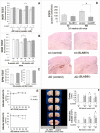



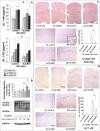
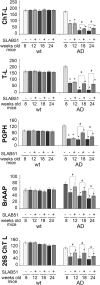
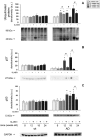
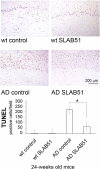
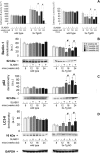
Similar articles
-
Emerging role of gut microbiota in modulation of neuroinflammation and neurodegeneration with emphasis on Alzheimer's disease.Prog Neuropsychopharmacol Biol Psychiatry. 2021 Mar 2;106:110112. doi: 10.1016/j.pnpbp.2020.110112. Epub 2020 Sep 16. Prog Neuropsychopharmacol Biol Psychiatry. 2021. PMID: 32949638 Review.
-
Gut microbiota modulation in Alzheimer's disease: Focus on lipid metabolism.Clin Nutr. 2022 Mar;41(3):698-708. doi: 10.1016/j.clnu.2022.01.025. Epub 2022 Feb 2. Clin Nutr. 2022. PMID: 35158177
-
Microbiota modulation as preventative and therapeutic approach in Alzheimer's disease.FEBS J. 2021 May;288(9):2836-2855. doi: 10.1111/febs.15571. Epub 2020 Oct 8. FEBS J. 2021. PMID: 32969566 Review.
-
Gut microbiota manipulation through probiotics oral administration restores glucose homeostasis in a mouse model of Alzheimer's disease.Neurobiol Aging. 2020 Mar;87:35-43. doi: 10.1016/j.neurobiolaging.2019.11.004. Epub 2019 Nov 11. Neurobiol Aging. 2020. PMID: 31813629
-
Strategic Modification of Gut Microbiota through Oral Bacteriotherapy Influences Hypoxia Inducible Factor-1α: Therapeutic Implication in Alzheimer's Disease.Int J Mol Sci. 2021 Dec 29;23(1):357. doi: 10.3390/ijms23010357. Int J Mol Sci. 2021. PMID: 35008786 Free PMC article.
Cited by
-
Kefir metabolites in a fly model for Alzheimer's disease.Sci Rep. 2021 May 27;11(1):11262. doi: 10.1038/s41598-021-90749-8. Sci Rep. 2021. PMID: 34045626 Free PMC article.
-
Implications of Microorganisms in Alzheimer's Disease.Curr Issues Mol Biol. 2022 Sep 30;44(10):4584-4615. doi: 10.3390/cimb44100314. Curr Issues Mol Biol. 2022. PMID: 36286029 Free PMC article. Review.
-
Transplantation of fecal microbiota from APP/PS1 mice and Alzheimer's disease patients enhanced endoplasmic reticulum stress in the cerebral cortex of wild-type mice.Front Aging Neurosci. 2022 Jul 28;14:858130. doi: 10.3389/fnagi.2022.858130. eCollection 2022. Front Aging Neurosci. 2022. PMID: 35966768 Free PMC article.
-
Gut Bacteria Provide Genetic and Molecular Reporter Systems to Identify Specific Diseases.Int J Mol Sci. 2024 Apr 17;25(8):4431. doi: 10.3390/ijms25084431. Int J Mol Sci. 2024. PMID: 38674014 Free PMC article. Review.
-
Advances in molecular mechanisms and therapeutic strategies for central nervous system diseases based on gut microbiota imbalance.J Adv Res. 2025 Mar;69:261-278. doi: 10.1016/j.jare.2024.03.023. Epub 2024 Apr 3. J Adv Res. 2025. PMID: 38579985 Free PMC article. Review.
References
Publication types
MeSH terms
Substances
LinkOut - more resources
Full Text Sources
Other Literature Sources
Medical

